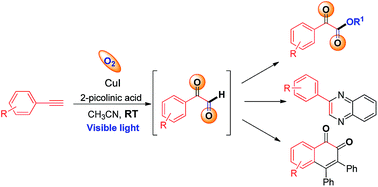当前位置:
X-MOL 学术
›
Chem. Sci.
›
论文详情
Our official English website, www.x-mol.net, welcomes your
feedback! (Note: you will need to create a separate account there.)
Copper catalyzed photoredox synthesis of α-keto esters, quinoxaline, and naphthoquinone: controlled oxidation of terminal alkynes to glyoxals†
Chemical Science ( IF 7.6 ) Pub Date : 2018-08-29 00:00:00 , DOI: 10.1039/c8sc03447h Deb Kumar Das 1, 2, 3, 4 , V. Kishore Kumar Pampana 1, 2, 3, 4 , Kuo Chu Hwang 1, 2, 3, 4
Chemical Science ( IF 7.6 ) Pub Date : 2018-08-29 00:00:00 , DOI: 10.1039/c8sc03447h Deb Kumar Das 1, 2, 3, 4 , V. Kishore Kumar Pampana 1, 2, 3, 4 , Kuo Chu Hwang 1, 2, 3, 4
Affiliation

|
Herein, we report a facile visible light induced copper catalyzed controlled oxidation of terminal C![[triple bond, length as m-dash]](https://www.rsc.org/images/entities/char_e002.gif) C alkynes to α-keto esters and quinoxalines via formation of phenylglyoxals as stable intermediates, under mild conditions by using molecular O2 as a sustainable oxidant. The current copper catalysed photoredox method is simple, highly functional group compatible with a broad range of electron rich and electron poor aromatic alkynes as well as aliphatic alcohols (1°, 2° and 3° alcohols), providing an efficient route for the preparation of α-keto esters (43 examples), quinoxaline and naphthoquinone with higher yields than those in the literature reported thermal processes. Furthermore, the synthetic utility of the products has been demonstrated in the synthesis of two biologically active molecules, an E. coli DHPS inhibitor and CFTR activator, using the current photoredox process. In addition, we applied this methodology to the one-pot synthesis of a heterocyclic compound (quinoxaline, an FLT3 inhibitor) by trapping the intermediate phenylglyoxal with O-phenylenediamine. The intermediate phenylglyoxal can also be isolated and further reacted with an internal alkyne to form naphthoquinone. This process can be readily scaled up to the gram scale.
C alkynes to α-keto esters and quinoxalines via formation of phenylglyoxals as stable intermediates, under mild conditions by using molecular O2 as a sustainable oxidant. The current copper catalysed photoredox method is simple, highly functional group compatible with a broad range of electron rich and electron poor aromatic alkynes as well as aliphatic alcohols (1°, 2° and 3° alcohols), providing an efficient route for the preparation of α-keto esters (43 examples), quinoxaline and naphthoquinone with higher yields than those in the literature reported thermal processes. Furthermore, the synthetic utility of the products has been demonstrated in the synthesis of two biologically active molecules, an E. coli DHPS inhibitor and CFTR activator, using the current photoredox process. In addition, we applied this methodology to the one-pot synthesis of a heterocyclic compound (quinoxaline, an FLT3 inhibitor) by trapping the intermediate phenylglyoxal with O-phenylenediamine. The intermediate phenylglyoxal can also be isolated and further reacted with an internal alkyne to form naphthoquinone. This process can be readily scaled up to the gram scale.
中文翻译:

α-酮酯、喹喔啉和萘醌的铜催化光氧化还原合成:末端炔烃受控氧化为乙二醛†
在此,我们报道了一种在温和条件下使用分子 O 2通过形成苯基乙二醛作为稳定的中间体,在可见光诱导的铜催化下,末端 C![[三键,长度为 m-dash]](https://www.rsc.org/images/entities/char_e002.gif) C 炔烃可控氧化为 α-酮酯和喹喔啉的方法。作为一种可持续的氧化剂。目前的铜催化光氧化还原方法简单、官能团高,与广泛的富电子和贫电子芳烃以及脂肪醇(1°、2°和3°醇)相容,为制备α-酮酯(43 个例子)、喹喔啉和萘醌的产率高于文献报道的热工艺。此外,该产品的合成效用已在两种生物活性分子的合成中得到证明,即大肠杆菌DHPS 抑制剂和 CFTR 活化剂,使用当前的光氧化还原过程。此外,我们将该方法应用于杂环化合物(喹喔啉,一种 FLT3 抑制剂)的一锅合成,方法是用邻苯二胺。也可以分离中间体苯乙二醛并进一步与内部炔烃反应以形成萘醌。这个过程可以很容易地放大到克级。
C 炔烃可控氧化为 α-酮酯和喹喔啉的方法。作为一种可持续的氧化剂。目前的铜催化光氧化还原方法简单、官能团高,与广泛的富电子和贫电子芳烃以及脂肪醇(1°、2°和3°醇)相容,为制备α-酮酯(43 个例子)、喹喔啉和萘醌的产率高于文献报道的热工艺。此外,该产品的合成效用已在两种生物活性分子的合成中得到证明,即大肠杆菌DHPS 抑制剂和 CFTR 活化剂,使用当前的光氧化还原过程。此外,我们将该方法应用于杂环化合物(喹喔啉,一种 FLT3 抑制剂)的一锅合成,方法是用邻苯二胺。也可以分离中间体苯乙二醛并进一步与内部炔烃反应以形成萘醌。这个过程可以很容易地放大到克级。
更新日期:2018-08-29
![[triple bond, length as m-dash]](https://www.rsc.org/images/entities/char_e002.gif) C alkynes to α-keto esters and quinoxalines via formation of phenylglyoxals as stable intermediates, under mild conditions by using molecular O2 as a sustainable oxidant. The current copper catalysed photoredox method is simple, highly functional group compatible with a broad range of electron rich and electron poor aromatic alkynes as well as aliphatic alcohols (1°, 2° and 3° alcohols), providing an efficient route for the preparation of α-keto esters (43 examples), quinoxaline and naphthoquinone with higher yields than those in the literature reported thermal processes. Furthermore, the synthetic utility of the products has been demonstrated in the synthesis of two biologically active molecules, an E. coli DHPS inhibitor and CFTR activator, using the current photoredox process. In addition, we applied this methodology to the one-pot synthesis of a heterocyclic compound (quinoxaline, an FLT3 inhibitor) by trapping the intermediate phenylglyoxal with O-phenylenediamine. The intermediate phenylglyoxal can also be isolated and further reacted with an internal alkyne to form naphthoquinone. This process can be readily scaled up to the gram scale.
C alkynes to α-keto esters and quinoxalines via formation of phenylglyoxals as stable intermediates, under mild conditions by using molecular O2 as a sustainable oxidant. The current copper catalysed photoredox method is simple, highly functional group compatible with a broad range of electron rich and electron poor aromatic alkynes as well as aliphatic alcohols (1°, 2° and 3° alcohols), providing an efficient route for the preparation of α-keto esters (43 examples), quinoxaline and naphthoquinone with higher yields than those in the literature reported thermal processes. Furthermore, the synthetic utility of the products has been demonstrated in the synthesis of two biologically active molecules, an E. coli DHPS inhibitor and CFTR activator, using the current photoredox process. In addition, we applied this methodology to the one-pot synthesis of a heterocyclic compound (quinoxaline, an FLT3 inhibitor) by trapping the intermediate phenylglyoxal with O-phenylenediamine. The intermediate phenylglyoxal can also be isolated and further reacted with an internal alkyne to form naphthoquinone. This process can be readily scaled up to the gram scale.
中文翻译:

α-酮酯、喹喔啉和萘醌的铜催化光氧化还原合成:末端炔烃受控氧化为乙二醛†
在此,我们报道了一种在温和条件下使用分子 O 2通过形成苯基乙二醛作为稳定的中间体,在可见光诱导的铜催化下,末端 C
![[三键,长度为 m-dash]](https://www.rsc.org/images/entities/char_e002.gif) C 炔烃可控氧化为 α-酮酯和喹喔啉的方法。作为一种可持续的氧化剂。目前的铜催化光氧化还原方法简单、官能团高,与广泛的富电子和贫电子芳烃以及脂肪醇(1°、2°和3°醇)相容,为制备α-酮酯(43 个例子)、喹喔啉和萘醌的产率高于文献报道的热工艺。此外,该产品的合成效用已在两种生物活性分子的合成中得到证明,即大肠杆菌DHPS 抑制剂和 CFTR 活化剂,使用当前的光氧化还原过程。此外,我们将该方法应用于杂环化合物(喹喔啉,一种 FLT3 抑制剂)的一锅合成,方法是用邻苯二胺。也可以分离中间体苯乙二醛并进一步与内部炔烃反应以形成萘醌。这个过程可以很容易地放大到克级。
C 炔烃可控氧化为 α-酮酯和喹喔啉的方法。作为一种可持续的氧化剂。目前的铜催化光氧化还原方法简单、官能团高,与广泛的富电子和贫电子芳烃以及脂肪醇(1°、2°和3°醇)相容,为制备α-酮酯(43 个例子)、喹喔啉和萘醌的产率高于文献报道的热工艺。此外,该产品的合成效用已在两种生物活性分子的合成中得到证明,即大肠杆菌DHPS 抑制剂和 CFTR 活化剂,使用当前的光氧化还原过程。此外,我们将该方法应用于杂环化合物(喹喔啉,一种 FLT3 抑制剂)的一锅合成,方法是用邻苯二胺。也可以分离中间体苯乙二醛并进一步与内部炔烃反应以形成萘醌。这个过程可以很容易地放大到克级。









































 京公网安备 11010802027423号
京公网安备 11010802027423号